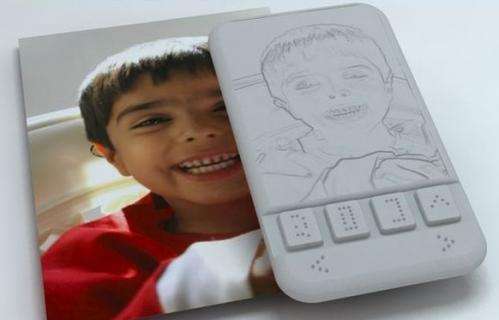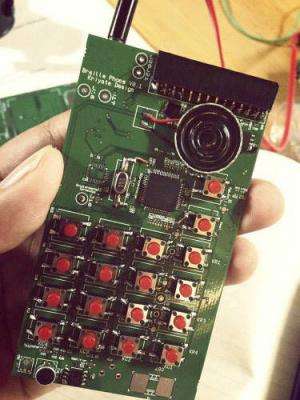(Phys.org) —Indian company Kriyate Design Solutions, headed and run by post-graduate student Sumit Dagar, has built a prototype Braille smartphone that makes use of a type of shape metal alloy to cause pins to raise and lower on a touchscreen—it allows users to read what is being sent using only their fingertips.
The project is being funded by the Rolex Awards—five people with promising ideas are given money every two years to develop innovative technologies. Dagar and his company are working with the Indian Institute of Technology and the prototype they've created is set to be tested by the L V Prasad Eye Institute. Dagar reportedly came up with the idea for a Braille phone on his own while attending India's National Institute of Design. Upon graduation he formed Kriyate Design Solutions with the express goal of creating a fully functional Braille smartphone. His idea all along has been to build a smartphone that fully implements Braille, allowing those who use it to send and receive text messages. The prototype is able to do just that by making use of metal in the form of pins that expands and contracts just enough to be felt by the fingertips. Incoming text is converted to Braille allowing the phone to express letters, numbers and even pictures allowing users to read information that others send, or from the Internet.
Up till now, blind people have had to rely on apps (such as Georgie developed by Sight and Sound Technology) to use their smartphones. Such apps typically make use of GPS to help those that cannot see find their way around unknown areas and to help read signs, menus, etc. With this new innovation, blind users will be able to send and receive text messages, read web content, use custom apps (including those with GPS abilities) and even take pictures of things and look at them using their fingers. It's a significant step forward and likely would not have occurred had not an insightful person come up with a workable idea, and then been backed by a company with very deep pockets and no expectations of making a profit from its investment.
The phone has been under design and development for three years and is now ready for testing. If successful, Dagar and his company plan to begin selling the phone to the public for as little as $185.
More information: via TimesofIndia
© 2013 Phys.org
























